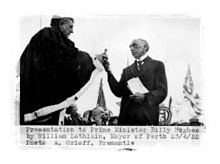 |
William Morris Hughes (1862-1952)
 William ('Billy') Hughes was born in Pimlico London and from
the age of seven was raised in his Welsh-speaking aunt's house in Llandudno,
Wales. In October 1884 he migrated to Queensland, where he drifted through
a range of jobs before finally settling in Sydney two years later.
William ('Billy') Hughes was born in Pimlico London and from
the age of seven was raised in his Welsh-speaking aunt's house in Llandudno,
Wales. In October 1884 he migrated to Queensland, where he drifted through
a range of jobs before finally settling in Sydney two years later.
Hughes became active in the labour movement in the early 1890s, winning
a seat in the New South Wales Legislative Assembly as a Labor candidate
in 1894. Although opposed to Federation on the terms being offered, Hughes
switched to Federal politics in 1901 and served as a minister in several
Labor governments. In October 1915 he became Prime Minister, and after visiting
first London to confer with the British Government and then the Somme on
the Western front to inspect the Australian troops stationed there, he returned
to Australia in 1916 to launch a 'Yes' campaign for a referendum to introduce
conscription. After strong opposition from within the Labor Party he was
expelled following the referendum's defeat.
With his former party split by the conscription issue, Hughes joined with a number of Labor defectors and the opposition to form the National Party which swept to power in the May 1917 elections. Hughes fought and lost a second referendum on conscription in 1917, remaining Prime Minister until 1922. Hughes stayed in Parliament, alienated from the party he had helped to found, eventually suffering expulsion. After serving as a minister in Joseph Lyons' United Australia Party, Hughes was again expelled, ending his parliamentary career as a member of the new Liberal Party formed by Menzies from the wreckage of the old U.A.P.
When he came to Western Australia in 1933 to argue the case against secession
Hughes was over seventy, but happy to enter into good-natured debates with
often hostile crowds, winning a hearing through his wit and good humour.
|
 |